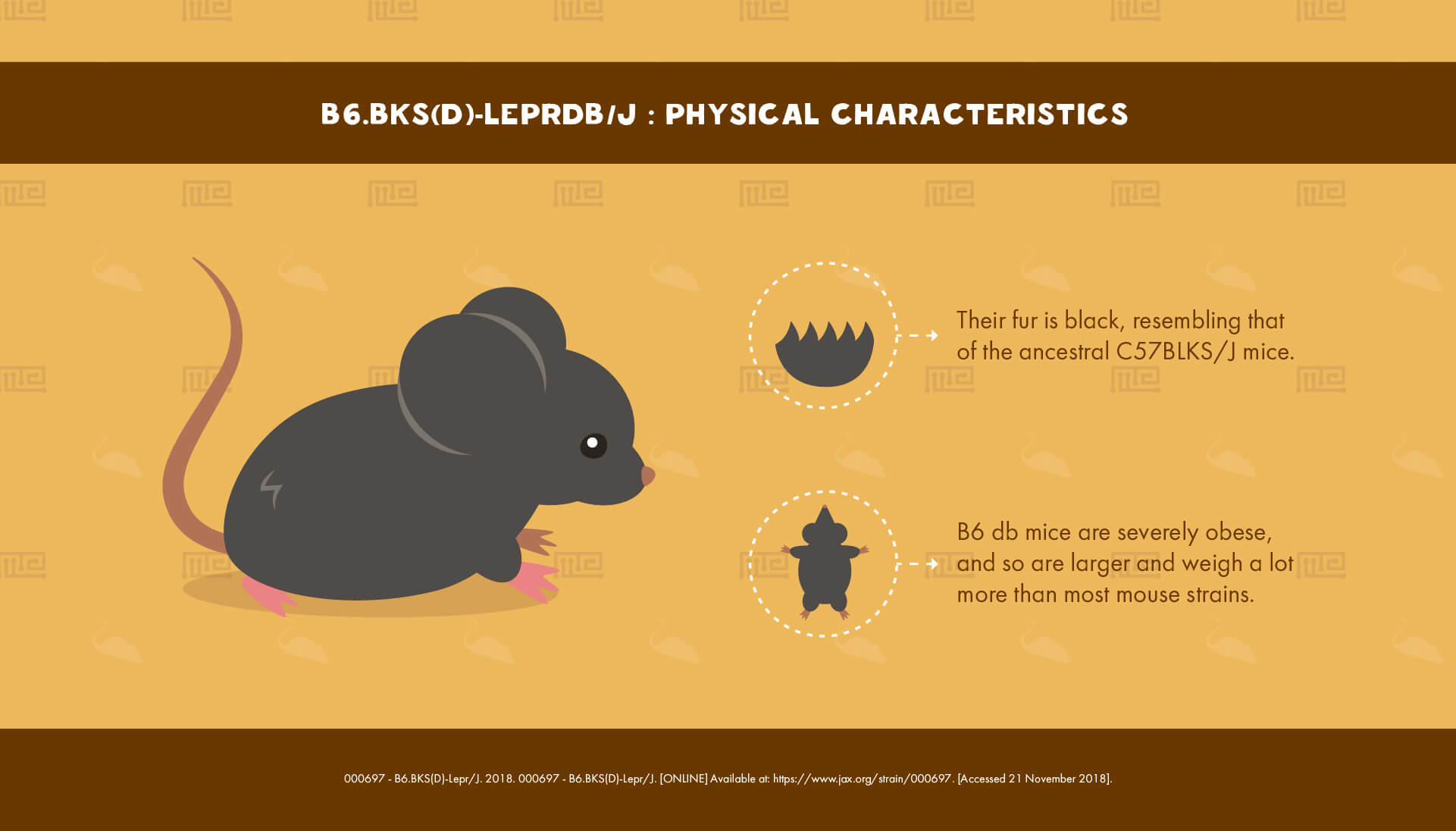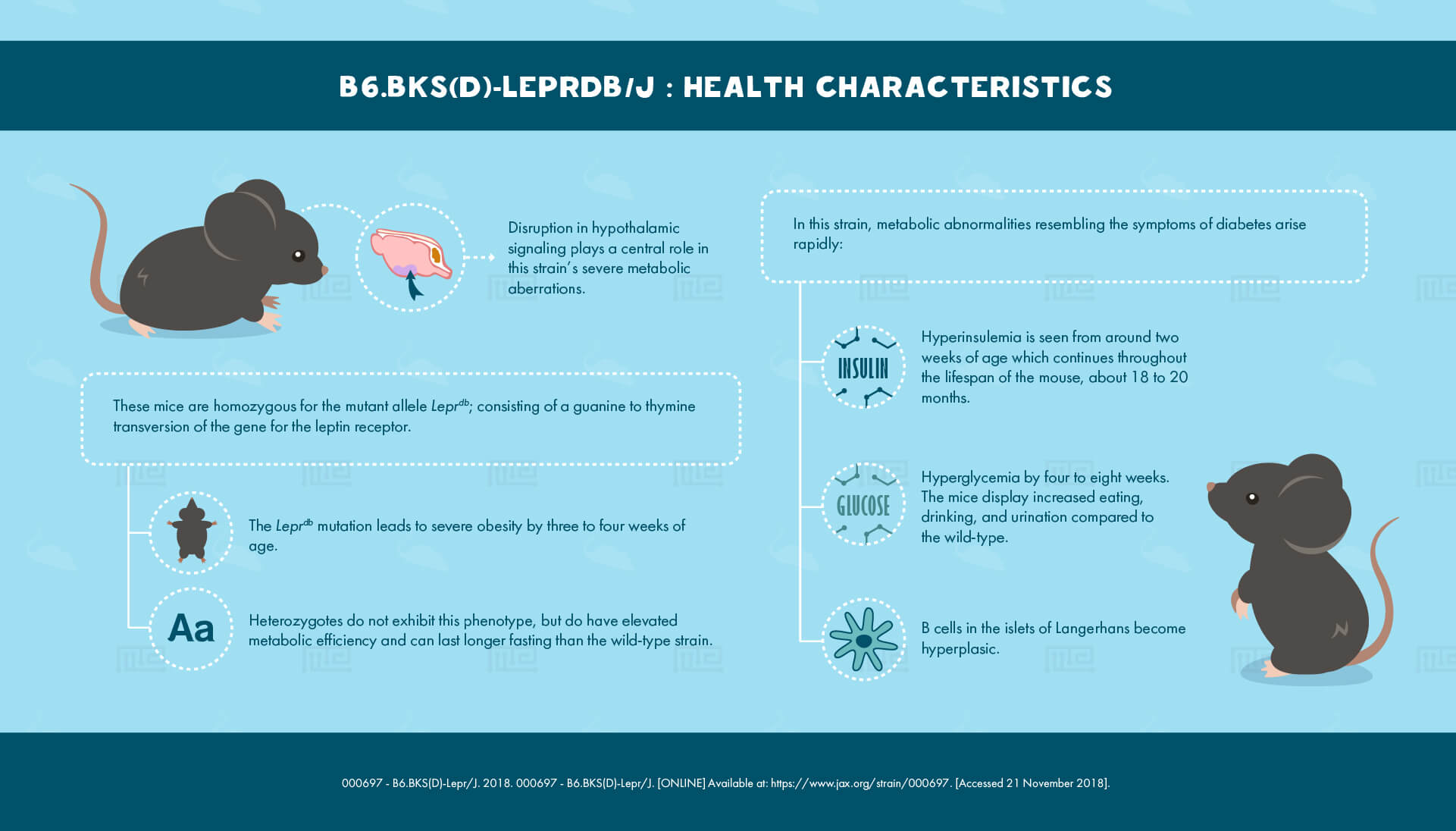Overview
B6.BKS(D)-Leprdb/J mouse strain, also known as B6 db, is a strain of mouse model that exhibits an obese and diabetic phenotype. Hence, it is of most interest in metabolic research.[1]
History
B6 db mice are derived from the inbred strain C57BLKS/J, which was accidentally developed by Kaliss in the 1940s from a stock of C57BL/6J.[2] A spontaneous mutation conferring a diabetic and obese phenotype arose in a stock of C57BLKS/J mice kept at the Jackson Laboratory and was discovered in 1966. It was cloned and developed into a separate lineage. This lineage originally contained the misty allele, but this was bred out in 2009.[1]
Physical Characteristics
B6 db mice are severely obese, and so are larger and weigh a lot more than most mouse strains. Their fur is black, resembling that of the ancestral C57BLKS/J mice.[1]
Behavioral Characteristics & Handling
No information on the handling of this strain could be found. If having a relatively more docile strain is essential, researchers may want to avoid B6 db as a precautionary measure.
A number of behavioral abnormalities have been observed with homozygous db mice on the BKS background. With regard to mood, researchers report depressive-like symptoms, as shown by higher immobility in the forced swimming test and tail suspension test.[3] Results on anxiety are inconsistent, with one study showing less anxiety and another showing greater anxiety in the elevated plus maze.[4][3]
These mice show a psychosis-like phenotype in an acoustic startle test, with a greatly reduced pre-pulse startle. They also exhibit memory deficits, including deficits in spatial working memory in the Y maze, and in recognition memory in the novel object recognition test. It is worth bearing in mind that these tests were conducted with db/db mice on the pure BKS background, and the results may not perfectly translate to mice on the B6.BKS background.
Health Characteristics of B6.BKS(D)-Leprdb/J Mouse Strain
These mice are homozygous for the mutant allele Leprdb; the mutation consists of a guanine to thymine transversion of the gene for the leptin receptor, resulting in abnormal splicing of the mRNA, and premature termination of the protein. The protein hence loses its signal transduction capabilities.
The hormone leptin is released by adipose cells and binds to the leptin receptor in the hypothalamus, regulating food intake. The Leprdb mutation disrupts this regulation, causing the mouse to develop severe obesity by three to four weeks of age. Heterozygotes do not exhibit this phenotype, but do have elevated metabolic efficiency and can last longer fasting than the wild-type strain.
Metabolic abnormalities resembling the symptoms of diabetes arise rapidly: hyperinsulemia is seen from around two weeks of age, and hyperglycemia by four to eight weeks. The mice display increased eating, drinking, and urination compared to the wild-type. B cells in the islets of Langerhans become hyperplasic. Hyperinsulemia continues throughout the lifespan of the mouse, which is about 18 to 20 months.
Lesioning of the ventromedial nucleus of the hypothalamus mitigates the pathological phenotype, confirming that a disruption in hypothalamic signaling plays a central role in this strain’s severe metabolic aberrations.[1]
Major Experimental Uses
Given the various metabolic abnormalities of B6 db, the strain is mostly of interest to researchers looking into obesity and diabetes. In particular, the symptoms of the strain resemble those of type two diabetics whose obesity has induced insulin resistance as a consequence of chronically elevated insulin levels.
B6 db is also useful for the study of endocrine system abnormalities, especially defects of the hypothalamus and pituitary gland, as well as abnormalities of the immune system, reproductive system, adipose, and pancreas.[1]
References
- 000697 – B6.BKS(D)-Lepr/J. 2018. 000697 – B6.BKS(D)-Lepr/J. [ONLINE] Available at: https://www.jax.org/strain/000697. [Accessed 21 November 2018].
- 000662 – C57BLKS/J. 2018. 000662 – C57BLKS/J. [ONLINE] Available at: https://www.jax.org/strain/000662. [Accessed 21 November 2018].
- Dinel, A. L., André, C., Aubert, A., Ferreira, G., Layé, S., & Castanon, N. 2011. Cognitive and emotional alterations are related to hippocampal inflammation in a mouse model of metabolic syndrome. PloS one. 6(9), e24325.
- Sharma, A. N., Elased, K. M., Garrett, T. L., & Lucot, J. B. 2010. Neurobehavioral deficits in db/db diabetic mice. Physiology & behavior. 101(3), 381-8.


